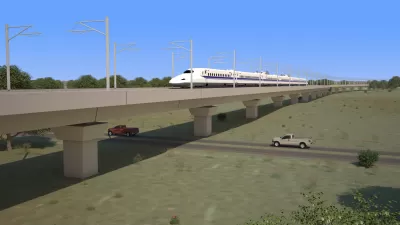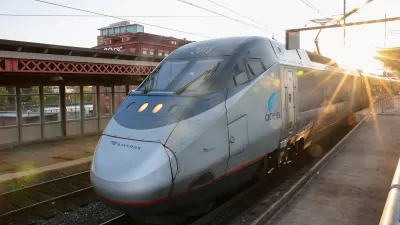Author Tom Vanderbilt suggests that train service has been headed in the wrong direction for the better part of a century.
"There is at least one technology in America...that is worse now than it was in the early 20th century: the train.
I have recently been poring over a number of prewar train timetables-not surprisingly, available on eBay. They are fascinating, filled with evocations of that fabled "golden era" of train travel. "You travel with friends on The Milwaukee Road," reads an ad in one, showing an avuncular conductor genially conversing with a jaunty, smartly dressed couple, the man on the verge of lighting a pipe. The brochure for the Montreal Limited, from an era when "de luxe" was still two words, assures travelers that 'modern air-conditioning scientifically controls temperature, humidity and purity of air at all seasons.'
But the most striking aspect of these antiquated documents is found in the tiny agate columns of arrivals and destinations. It is here that one sees the wheels of progress actually running backward. The aforementioned Montreal Limited, for example, circa 1942, would pull out of New York's Grand Central Station at 11:15 p.m., arriving at Montreal's (now defunct) Windsor Station at 8:25 a.m., a little more than nine hours later. To make that journey today, from New York's Penn Station on the Adirondack, requires a nearly 12-hour ride. The trip from Chicago to Minneapolis via the Olympian Hiawatha in the 1950s took about four and a half hours; today, via Amtrak's Empire Builder, the journey is more than eight hours. Going from Brattleboro, Vt., to New York City on the Boston and Maine Railroad's Washingtonian took less than five hours in 1938; today, Amtrak's Vermonter (the only option) takes six hours-if it's on time, which it isn't, nearly 75 percent of the time."
Thanks to Franny Ritchie
FULL STORY: Stop This Train!Are trains slower now than they were in the 1920s?

Alabama: Trump Terminates Settlements for Black Communities Harmed By Raw Sewage
Trump deemed the landmark civil rights agreement “illegal DEI and environmental justice policy.”

Planetizen Federal Action Tracker
A weekly monitor of how Trump’s orders and actions are impacting planners and planning in America.

The 120 Year Old Tiny Home Villages That Sheltered San Francisco’s Earthquake Refugees
More than a century ago, San Francisco mobilized to house thousands of residents displaced by the 1906 earthquake. Could their strategy offer a model for the present?

Ken Jennings Launches Transit Web Series
The Jeopardy champ wants you to ride public transit.

BLM To Rescind Public Lands Rule
The change will downgrade conservation, once again putting federal land at risk for mining and other extractive uses.

Indy Neighborhood Group Builds Temporary Multi-Use Path
Community members, aided in part by funding from the city, repurposed a vehicle lane to create a protected bike and pedestrian path for the summer season.
Urban Design for Planners 1: Software Tools
This six-course series explores essential urban design concepts using open source software and equips planners with the tools they need to participate fully in the urban design process.
Planning for Universal Design
Learn the tools for implementing Universal Design in planning regulations.
Clanton & Associates, Inc.
Jessamine County Fiscal Court
Institute for Housing and Urban Development Studies (IHS)
City of Grandview
Harvard GSD Executive Education
Toledo-Lucas County Plan Commissions
Salt Lake City
NYU Wagner Graduate School of Public Service





























